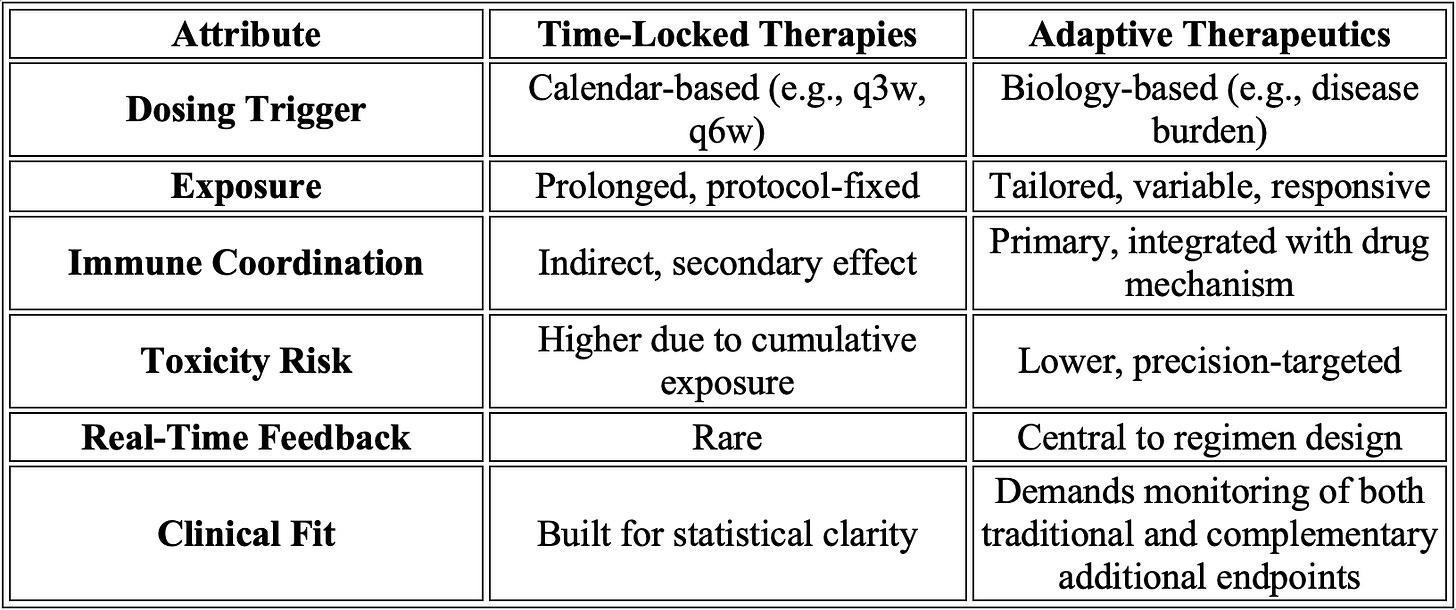Timing vs. Biology: The Era of Rose Bengal Sodium-based Medicines Will Be System-Aware, Not Schedule-Bound
For decades, much of the healthcare industry has treated time as a stand-in for the real understanding of biology when treating disease.
Dosing regimens—chemotherapy every three weeks or immunotherapy every three or six—were built around chronological regularity, not biological reality.
These “time-locked therapies” helped standardize care. Their advocates and promoters saw disease as linear and compartmentalized.
At Provectus, we think deeper. Disease is not timed—it’s dynamic. The body is not a calendar—it’s a system.
To match the complexity of the body, we believe the next generation of therapies, such as medicines based on Provectus’s bioactive small molecule Rose Bengal Sodium (RBS), will shift from time-fixed to system-synced. From schedule-driven to biology-aware. From static regimens to adaptive therapeutics.
The Case for System-Aware Therapeutics
Our bodies are not passive targets. They’re interactive operating systems, constantly recalibrating immunity, metabolism, redox signaling, tissue repair, and several other core mechanisms.
When these systems go offline, we call it cancer, infection, chronic inflammation, or some other disease.
When they’re brought back online, we call it healing.
The best therapies of tomorrow will be the most fluent. They’ll be built to communicate with biological systems, not override them.
They’ll listen. Then act. Then stop.
Time-Locked vs. Adaptive: A Strategic Shift
We must now ask: Are we treating the tumor—or just following a calendar? Are we delivering a drug—or sending a signal the body understands?
A Biological OS Requires Adaptive Logic
Think of the body as a biological operating system (OS). For example:
Immune checkpoints are system permissions,
Mitochondria are energy drivers and error sensors,
Inflammation is both a patch and a crash report, and
Oxidative stress is a signaling interface, not just damage.
When disease happens, it’s often a network failure, not a single target malfunction.
Instead of installing another app (i.e., drug) to override a problem, imagine rebooting the core system.
That’s the promise of adaptive therapeutics: they act more like software patches than hardware force.
Spotlight: Rose Bengal Sodium as a System-Synced Case Study
One molecule that illustrates this logic is, we believe, Provectus’s Rose Bengal Sodium.
RBS’s action is system-oriented. Among other things, RBS:
Generates selective oxidative stress in diseased tissue;
Induces immunogenic cell death—turning tumors into self-vaccines;
Promotes immune clearance and tissue repair; and
Most critically: Is administered based on tumor burden, not time.
RBS is given only when there are tumors to treat. Treatment stops when disease regresses. Treatment resumes only if new lesions appear.
That’s not time-based therapy. That’s feedback-based medicine.
A Vision of What Comes Next
To enable this shift at scale, we’ll use:
Real-time diagnostics to track disease activity (e.g., PET-CT), not just presence;
Regulatory understanding to allow non-linear dosing schedules;
Clinical endpoints that reward restoration, not just reduction; and
Investors willing to help us build adaptive platforms, not just pipelines.
Time-locked therapies built the modern drug industry. But they are not the final word.
Adaptive therapeutics will unlock a world where we treat what’s needed, when it’s needed—no more, no less.
Final Thought: From Protocols to Intelligence
Disease doesn’t run on a clock. Neither should our therapies.
We don’t need more time-based dosing calendars. We need biologically justified treatment rhythms.
Let’s stop asking, “What day is it in the cycle?”
Let’s start asking, “What does the body require now?”
Because the future of medicine won’t be measured in intervals. It will be measured by need.
Forward-Looking Statements
The information provided in this Provectus Substack Post may include forward-looking statements, within the meaning of the Private Securities Litigation Reform Act of 1995, relating to the business of Provectus and its affiliates, which are based on currently available information and current assumptions, expectations, and projections about future events and are subject to a variety of risks and uncertainties and other factors that could cause actual events or results to differ materially from those projected in the forward-looking statements. Such statements are made in reliance on the safe harbor provisions of Section 27A of the Securities Act of 1933 and Section 21E of the Securities Exchange Act of 1934. Forward-looking statements are often, but not always, identified by the use of words such as “aim,” “likely,” “outlook,” “seek,” “anticipate,” “budget,” “plan,” “continue,” “estimate,” “expect,” “forecast,” “may,” “will,” “would,” “project,” “projection,” “predict,” “potential,” “targeting,” “intend,” “can,” “could,” “might,” “should,” “believe,” and similar words suggesting future outcomes or statements regarding an outlook.
The safety and efficacy of Provectus’s drug agents and/or their uses under investigation have not been established. There is no guarantee that the agents will receive health authority approval or become commercially available in any country for the uses being investigated or that such agents as products will achieve any revenue levels.
Due to the risks, uncertainties, and assumptions inherent in forward-looking statements, readers should not place undue reliance on these forward-looking statements. The forward-looking statements contained in this Provectus Substack Post are made as of the date hereof or as of the date specifically specified herein, and the Company undertakes no obligation to update or revise any forward-looking statements, whether because of new information, future events, or otherwise, except in accordance with applicable securities laws. The forward-looking statements are expressly qualified by this cautionary statement.
Risks, uncertainties, and assumptions include those discussed in the Company’s filings with the U.S. Securities and Exchange Commission, including those described in Item 1A of Provectus’ Annual Report on Form 10-K for the period ended December 31, 2024.




